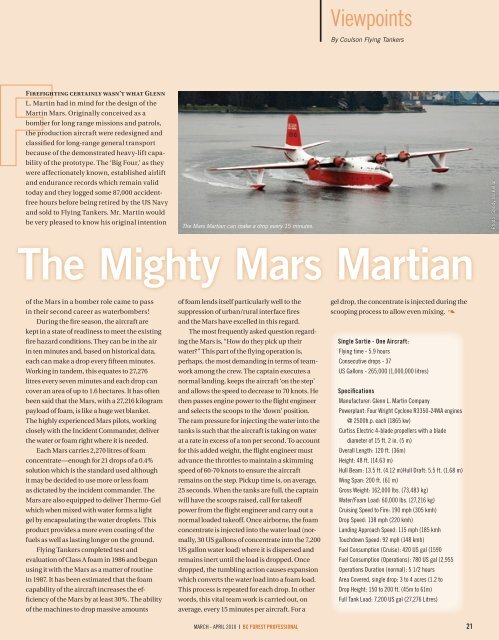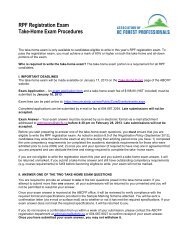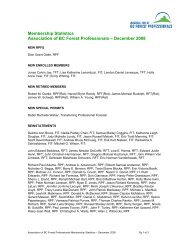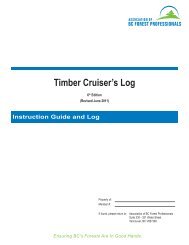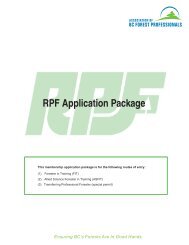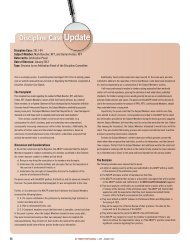VIEWPOINT - Association of BC Forest Professionals
VIEWPOINT - Association of BC Forest Professionals
VIEWPOINT - Association of BC Forest Professionals
You also want an ePaper? Increase the reach of your titles
YUMPU automatically turns print PDFs into web optimized ePapers that Google loves.
Firefighting certainly wasn’t what Glenn<br />
L. Martin had in mind for the design <strong>of</strong> the<br />
Martin Mars. Originally conceived as a<br />
bomber for long range missions and patrols,<br />
the production aircraft were redesigned and<br />
classified for long-range general transport<br />
because <strong>of</strong> the demonstrated heavy-lift capability<br />
<strong>of</strong> the prototype. The ‘Big Four,’ as they<br />
were affectionately known, established airlift<br />
and endurance records which remain valid<br />
today and they logged some 87,000 accidentfree<br />
hours before being retired by the US Navy<br />
and sold to Flying Tankers. Mr. Martin would<br />
be very pleased to know his original intention<br />
<strong>of</strong> the Mars in a bomber role came to pass<br />
in their second career as waterbombers!<br />
During the fire season, the aircraft are<br />
kept in a state <strong>of</strong> readiness to meet the existing<br />
fire hazard conditions. They can be in the air<br />
in ten minutes and, based on historical data,<br />
each can make a drop every fifteen minutes.<br />
Working in tandem, this equates to 27,276<br />
litres every seven minutes and each drop can<br />
cover an area <strong>of</strong> up to 1.6 hectares. It has <strong>of</strong>ten<br />
been said that the Mars, with a 27,216 kilogram<br />
payload <strong>of</strong> foam, is like a huge wet blanket.<br />
The highly experienced Mars pilots, working<br />
closely with the Incident Commander, deliver<br />
the water or foam right where it is needed.<br />
Each Mars carries 2,270 litres <strong>of</strong> foam<br />
concentrate—enough for 21 drops <strong>of</strong> a 0.4%<br />
solution which is the standard used although<br />
it may be decided to use more or less foam<br />
as dictated by the incident commander. The<br />
Mars are also equipped to deliver Thermo-Gel<br />
which when mixed with water forms a light<br />
gel by encapsulating the water droplets. This<br />
product provides a more even coating <strong>of</strong> the<br />
fuels as well as lasting longer on the ground.<br />
Flying Tankers completed test and<br />
evaluation <strong>of</strong> Class A foam in 1986 and began<br />
using it with the Mars as a matter <strong>of</strong> routine<br />
in 1987. It has been estimated that the foam<br />
capability <strong>of</strong> the aircraft increases the efficiency<br />
<strong>of</strong> the Mars by at least 30%. The ability<br />
<strong>of</strong> the machines to drop massive amounts<br />
The Mars Martian can make a drop every 15 minutes.<br />
<strong>of</strong> foam lends itself particularly well to the<br />
suppression <strong>of</strong> urban/rural interface fires<br />
and the Mars have excelled in this regard.<br />
The most frequently asked question regarding<br />
the Mars is, “How do they pick up their<br />
water?” This part <strong>of</strong> the flying operation is,<br />
perhaps, the most demanding in terms <strong>of</strong> teamwork<br />
among the crew. The captain executes a<br />
normal landing, keeps the aircraft ‘on the step’<br />
and allows the speed to decrease to 70 knots. He<br />
then passes engine power to the flight engineer<br />
and selects the scoops to the ‘down’ position.<br />
The ram pressure for injecting the water into the<br />
tanks is such that the aircraft is taking on water<br />
at a rate in excess <strong>of</strong> a ton per second. To account<br />
for this added weight, the flight engineer must<br />
advance the throttles to maintain a skimming<br />
speed <strong>of</strong> 60-70 knots to ensure the aircraft<br />
remains on the step. Pickup time is, on average,<br />
25 seconds. When the tanks are full, the captain<br />
will have the scoops raised, call for take<strong>of</strong>f<br />
power from the flight engineer and carry out a<br />
normal loaded take<strong>of</strong>f. Once airborne, the foam<br />
concentrate is injected into the water load (normally,<br />
30 US gallons <strong>of</strong> concentrate into the 7,200<br />
US gallon water load) where it is dispersed and<br />
remains inert until the load is dropped. Once<br />
dropped, the tumbling action causes expansion<br />
which converts the water load into a foam load.<br />
This process is repeated for each drop. In other<br />
words, this vital team work is carried out, on<br />
average, every 15 minutes per aircraft. For a<br />
MARCH - ApRil 2010 | <strong>BC</strong> FOREST PROFESSIONAL<br />
Viewpoints<br />
By Coulson Flying Tankers<br />
The Mighty Mars Martian<br />
gel drop, the concentrate is injected during the<br />
scooping process to allow even mixing. 3<br />
Single Sortie - One Aircraft:<br />
Flying time - 5.9 hours<br />
Consecutive drops - 37<br />
US Gallons - 265,000 (1,000,000 litres)<br />
Specifications<br />
Manufacturer: Glenn l. Martin Company<br />
powerplant: Four Wright Cyclone R3350-24WA engines<br />
@ 2500h.p. each (1865 kw)<br />
Curtiss Electric 4-blade propellers with a blade<br />
diameter <strong>of</strong> 15 ft. 2 in. (5 m)<br />
Overall length: 120 ft. (36m)<br />
Height: 48 ft. (14.63 m)<br />
Hull Beam: 13.5 ft. (4.12 m)Hull Draft: 5.5 ft. (1.68 m)<br />
Wing Span: 200 ft. (61 m)<br />
Gross Weight: 162,000 lbs. (73,483 kg)<br />
Water/Foam load: 60,000 lbs. (27,216 kg)<br />
Cruising Speed to Fire: 190 mph (305 kmh)<br />
Drop Speed: 138 mph (220 kmh)<br />
landing Approach Speed: 115 mph (185 kmh<br />
Touchdown Speed: 92 mph (148 kmh)<br />
Fuel Consumption (Cruise): 420 US gal (1590<br />
Fuel Consumption (Operations): 780 US gal (2,955<br />
Operations Duration (normal): 5 1/2 hours<br />
Area Covered, single drop: 3 to 4 acres (1.2 to<br />
Drop Height: 150 to 200 ft. (45m to 61m)<br />
Full Tank load: 7,200 US gal (27,276 litres)<br />
21<br />
Photo: Sandy McKellar


